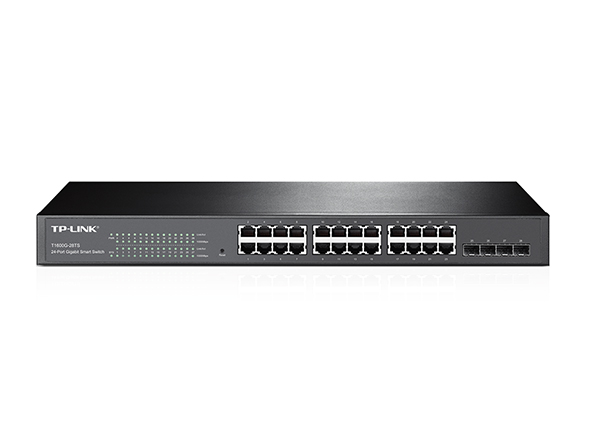Descarga para T1600G-28TS
- Product Overview
Archivos MIBs
|
T1600G-28TS_v1_MIB_20151215 |
Descargas | |
|---|---|---|
| Fecha de Publicación : 2015-12-15 | Idioma: Inglés | Tamaño del Archivo : 145 KB |
Sistema de Operación : Win2000/XP/2003/Vista/7/8/8.1/10/Mac/Linux |
||
|
Notes: For T1600G-28TS_v1_20151215 and subsequent versions |
||
Cliente 802.1X
|
TP-LINK_802.1X_Client_Software |
Descargas | |
|---|---|---|
| Fecha de Publicación : 2017-09-05 | Idioma: Inglés | Tamaño del Archivo : 5.5MB |
Sistema de Operación : Win2000/XP/2003/Vista/7/8/8.1/10 |
||
|
|
||
Preguntas Frecuentes
- How to configure LACP on our Smart/ Managed Switch
- How to Block Unknown Devices to Access the Switch by Using IP Source Guard
- Why the firmware version does not change after upgrading in T Series switches?
- How to Upgrade Firmware of a Switch via the Bootutil Menu
- How to configure IGMP Snooping for IPTV network using L2 switch
- How to configure the default gateway of the smart and managed switches using the old GUI
- How to build a Wireless Network for Chain Store using tp-link products
- How to build a Wireless Network for School Canteen using tp-link products
- How to set up an Enterprise VPN using tp-link products
- The difference between the Voice VLAN feature and Auto VOIP feature
- What should I do if I cannot access the web management page of my TP-Link switch?
- Do you still have any doubt about the effect of QoS on the Switch of TP-Link?
- How to block an illegal client with Certain IP address from getting access to the network using TP-Link Managed Switches
- How to configure switch as DHCP server on Standalone mode
- ¿Cómo cambiar la dirección IP del Switch TP-Link usando la Web GUI y CLI?
- How to configure MAC ACL on Smart/Managed switch
- How to configure the DHCP Relay in TP-Link Switch
- How to configure Voice VLAN to optimize the transmission of voice traffic on TP-Link Smart and Managed Switches using the new GUI
- How to configure OpenSSH 7.0(and above) to login smart and managed switches?
- The nodes that TP-Link T1600/T2600 series switch use to display the CPU and Memory utilization through SNMP
Firmware
A firmware update can resolve issues that the previous firmware version may have and improve its current performance.
To Upgrade
IMPORTANT: To prevent upgrade failures, please read the following before proceeding with the upgrade process
- Please upgrade firmware from the local TP-Link official website of the purchase location for your TP-Link device, otherwise it will be against the warranty. Please click here to change site if necessary.
- Please verify the hardware version of your device for the firmware version. Wrong firmware upgrade may damage your device and void the warranty. (Normally V1.x=V1)
¿Cómo encontrar la versión del hardware en un dispositivo TP-Link? - Do NOT turn off the power during the upgrade process, as it may cause permanent damage to the product.
- To avoid wireless disconnect issue during firmware upgrade process, it's recommended to upload firmware with wired connection unless there is no LAN/Ethernet port on your TP-Link device.
- It's recommended that users stop all Internet applications on the computer, or simply disconnect Internet line from the device before the upgrade.
- Use decompression software such as WinZIP or WinRAR to extract the file you download before the upgrade.
|
T1600G-28TS_v1_20151215 |
Descargas | |
|---|---|---|
| Fecha de Publicación : 2015-12-15 | Idioma: Inglés | Tamaño del Archivo : 13.47 MB |
|
Notes: First firmware released of T1600G-28TS_v1
|
||
Usar Firmware de Terceros en los Productos de TP-Link
Algunos firmware oficiales de los productos de TP-Link pueden ser sustituidos por el firmware de terceros como DD-WRT. TP-Link no está obligado a proporcionar el mantenimiento o soporte alguno para los mismos, y no garantiza el desempeño y la estabilidad del firmware de terceros. Los daños al producto como resultado del uso de firmware de terceros, anulará la garantía del producto.
Abrir el Código Fuente Para Programadores (GPL)
La siguiente información es para los programadores y no es necesaria para la mayoría de los usuarios particulares de TP-Link.
Los productos de TP-Link contienen en parte del código del software desarrollado por terceros, incluyendo el código del software sujeto a “GLP” (General Public Licence - Licencia Pública General) de GNU, Versión 1/Versión 2/Versión 3 o "LGPL" (Lesser General Public License – Licencia Pública General Reducida) de GNU. Puede usar la condición del software respectiva siguiendo los términos de la licencia de GPL.
Puede revisar, imprimir y descargar los términos respectivos de la licencia de GPL aquí. Usted recibe los códigos fuente de GPL del respectivo software utilizado en los productos de TP-Link para la descarga directa e información adicional, incluyendo una lista del software de TP-Link que contiene el código del software de GPL por el Centro de Códigos de GPL.
Los programas respectivos son distribuidos SIN NINGUNA GARANTÍA, incluso sin la garantía implícita de COMERCIABILIDAD o IDONEIDAD PARA UN PROPÓSITO PARTICULAR. Vea la Licencia Pública General respectiva de GNU para obtener más detalles.
GPL Code
Emulators
Versión de Firmware |
Modo de trabajo |
Idioma |
|
|---|---|---|---|
150605 |
- |
Inglés |
Note:
1. This Emulator is a virtual web GUI where you can program your TP-Link product firmware. For details about an individual product’s features and specifications please use the search facility and go to the product page.
2. Please check the firmware version corresponds to the version shown on the Emulator interface. Each firmware version has its own GUI and functionality.
3. Please note that not all firmware versions are represented on the Emulator.
 Switch Inteligente de 24 puertos Gigabit con 4 Ranuras SFP JetStream
Switch Inteligente de 24 puertos Gigabit con 4 Ranuras SFP JetStream